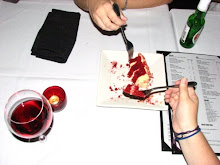In Steven C. Dubin's book, Displays of Power: Controversy in the American Museum from the Enola Gay to Sensation, museums are shown to be powerful institutions in which controversy is more likely to occur than agreement. Using examples such as the Enola Gay or the Gaelic Gotham exhibits, Dubin presents examples of how delicate museum exhibits can be to plan and how hard museum officials must work in order to achieve a success.
Like in Linenthal's book, many of Dubin's examples show the balancing act between the general public and the museum officials. The Gaelic Gotham exhibit was set to be the monument to Irish struggles in America. Instead, it became a breeding ground for misunderstanding and controversy. Most shocking to me about this exhibit was curator Robert McDonald's statement that “Gaelic Gotham is not for the Irish but about the Irish.” (103) This statement implies to me, that Irish input was not welcome by the museum even though the exhibit was expressly about the Irish experience in New York City. Although I can understand that listening to the general public that you are trying to serve can be trying and difficult at times, I do believe that it is necessary to do. The masses are going to be the people coming to see the exhibit, not professional historians and therefore should be allowed some input. Despite this, I did actually like McDonald's work strategy as presented through Dubin. This strategy stated that community input would be welcomed in the “preliminary, fact-finding stages” (239) and would have to proceed without this input during the “exhibition-building stages” (239). This would allow the museum room to design and arrange the exhibit as they saw fit. Unfortunately I don't believe McDonald followed his own advice when it came to Gaelic Gotham.
Although the individual chapters were somewhat interesting, I was critical of the fact that all were negative views on controversy in the American Museum. I do wonder if there are instances in which controversy actually improved the relationship between museum professionals and the public rather than break it down. Also, each chapter was a little too repetitive for my tastes, representing the same controversies and rifts between the museum world and the public. The last thing I did not like about this book was the afterword. Throughout the rest of the book, Dubin is careful to remain, for the most part, neutral about which side he identifies with. He presents both views on the controversy in clarity and with many examples to back it up. In the afterword however, the gloves come off. Suddenly it becomes essentially a Giuliani and Donahue bashing free-for-all. Now this is not my confession that I agree with these two men in any capacity, but this chapter just did not make any sense from a literary standpoint to me. While the rest of the book was carefully neutral, this last chapter was fiery and opinionated, upsetting the balance of the book. I think Dubin should have either toned down his opinion in the last chapter or had included it more often in the middle chapters.
Subscribe to:
Post Comments (Atom)

2 comments:
I too noticed the similarity with Linenthal regarding the balance between the public opinion and the exhibit creators, however it was interesting that right off the bat Dubin referred to his book as a discussion of the "consequences." I immediately thought that he'd include mostly negative views of these controversies, and he pretty much did.
I also agree with your discussion of his afterword. His shift in tone in the afterword is pretty evident. I pretty much ignored his attacks on the media and politicians, partly because it was an addition to the previous edition, but mostly because it seemed so out of context considering the rest of the book. The exhibit he discussed even seemed out of place. That might just be me though. I'm not really a huge fan of those shock exhibits.
I really like how you touch on how controversy can sometimes lead to enhancement and isn't always such a negative aspect of creation and success. Dubin does seem to focus on the negative aspects, perhaps that was his example option choices or maybe he just did not think there were positive aspects to these controversies.
Post a Comment